Page 55 of 426
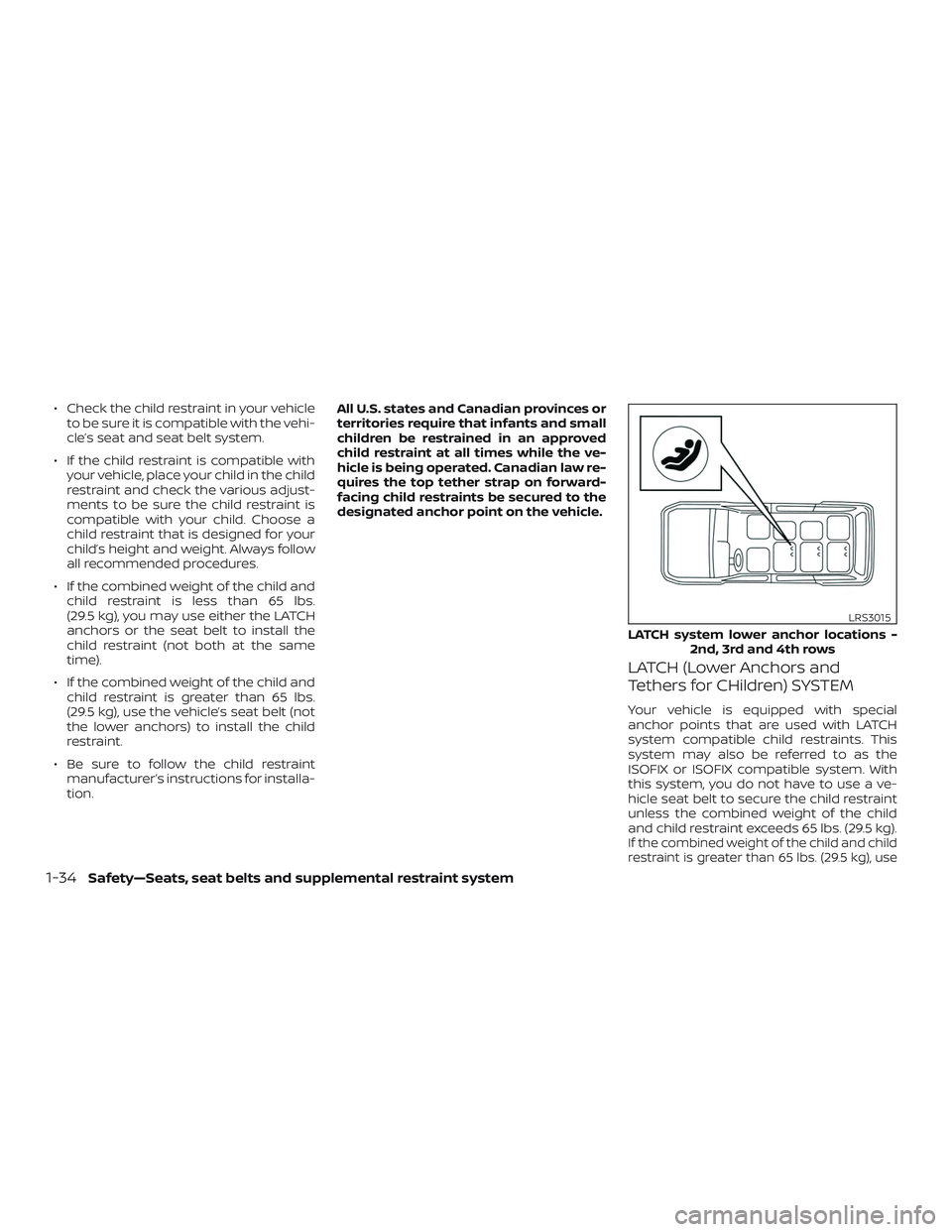
∙ Check the child restraint in your vehicleto be sure it is compatible with the vehi-
cle’s seat and seat belt system.
∙ If the child restraint is compatible with your vehicle, place your child in the child
restraint and check the various adjust-
ments to be sure the child restraint is
compatible with your child. Choose a
child restraint that is designed for your
child’s height and weight. Always follow
all recommended procedures.
∙ If the combined weight of the child and child restraint is less than 65 lbs.
(29.5 kg), you may use either the LATCH
anchors or the seat belt to install the
child restraint (not both at the same
time).
∙ If the combined weight of the child and child restraint is greater than 65 lbs.
(29.5 kg), use the vehicle’s seat belt (not
the lower anchors) to install the child
restraint.
∙ Be sure to follow the child restraint manufacturer’s instructions for installa-
tion. All U.S. states and Canadian provinces or
territories require that infants and small
children be restrained in an approved
child restraint at all times while the ve-
hicle is being operated. Canadian law re-
quires the top tether strap on forward-
facing child restraints be secured to the
designated anchor point on the vehicle.
LATCH (Lower Anchors and
Tethers for CHildren) SYSTEM
Your vehicle is equipped with special
anchor points that are used with LATCH
system compatible child restraints. This
system may also be referred to as the
ISOFIX or ISOFIX compatible system. With
this system, you do not have to use a ve-
hicle seat belt to secure the child restraint
unless the combined weight of the child
and child restraint exceeds 65 lbs. (29.5 kg).
If the combined weight of the child and child
restraint is greater than 65 lbs. (29.5 kg), use
LATCH system lower anchor locations -
2nd, 3rd and 4th rows
LRS3015
1-34Safety—Seats, seat belts and supplemental restraint system
Page 56 of 426
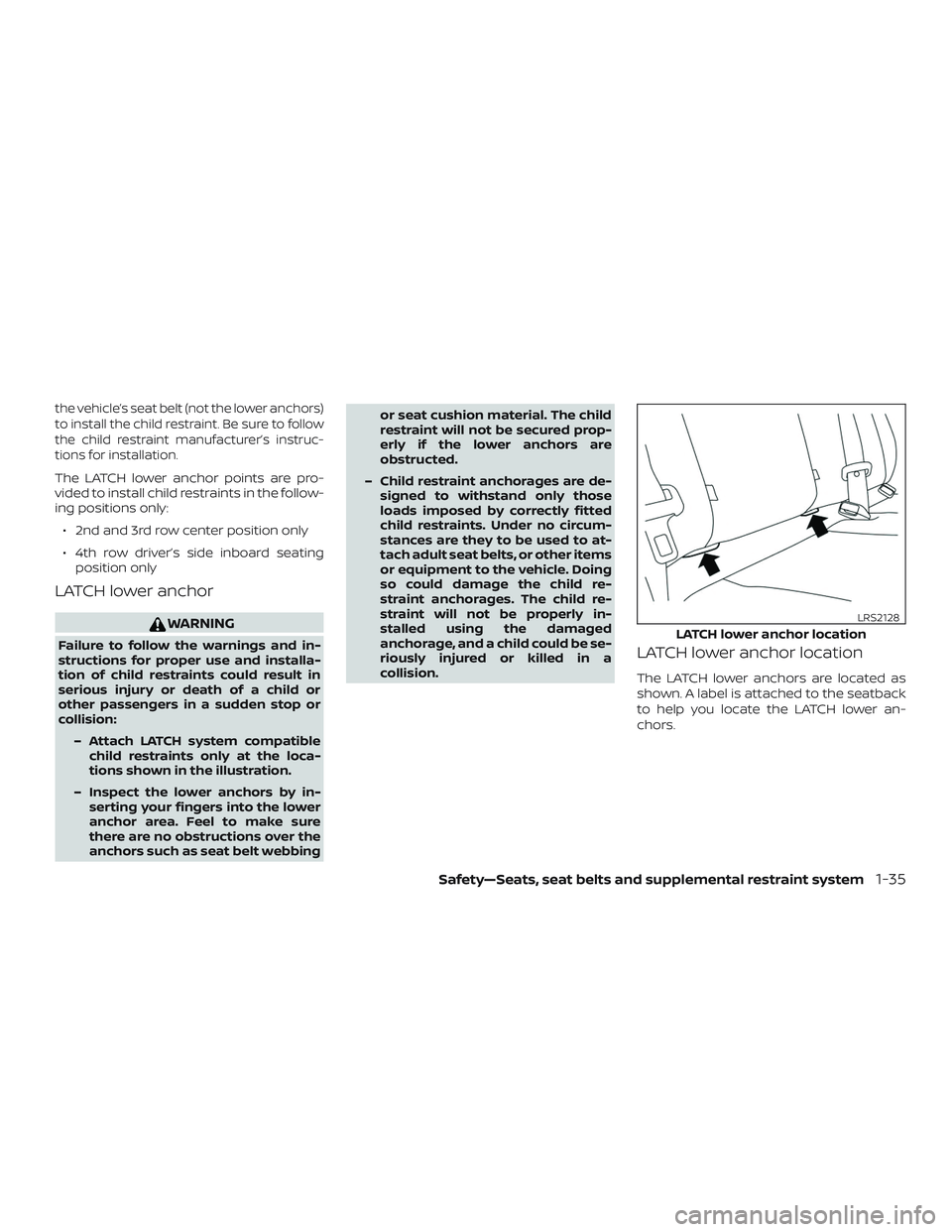
the vehicle’s seat belt (not the lower anchors)
to install the child restraint. Be sure to follow
the child restraint manufacturer’s instruc-
tions for installation.
The LATCH lower anchor points are pro-
vided to install child restraints in the follow-
ing positions only:∙ 2nd and 3rd row center position only
∙ 4th row driver’s side inboard seating position only
LATCH lower anchor
WARNING
Failure to follow the warnings and in-
structions for proper use and installa-
tion of child restraints could result in
serious injury or death of a child or
other passengers in a sudden stop or
collision:
– Attach LATCH system compatiblechild restraints only at the loca-
tions shown in the illustration.
– Inspect the lower anchors by in- serting your fingers into the lower
anchor area. Feel to make sure
there are no obstructions over the
anchors such as seat belt webbing or seat cushion material. The child
restraint will not be secured prop-
erly if the lower anchors are
obstructed.
– Child restraint anchorages are de- signed to withstand only those
loads imposed by correctly fitted
child restraints. Under no circum-
stances are they to be used to at-
tach adult seat belts, or other items
or equipment to the vehicle. Doing
so could damage the child re-
straint anchorages. The child re-
straint will not be properly in-
stalled using the damaged
anchorage, and a child could be se-
riously injured or killed in a
collision.LATCH lower anchor location
The LATCH lower anchors are located as
shown. A label is attached to the seatback
to help you locate the LATCH lower an-
chors.
LATCH lower anchor location
LRS2128
Safety—Seats, seat belts and supplemental restraint system1-35
Page 57 of 426

WARNING
Child restraint anchorages are de-
signed to withstand only those loads
imposed by correctly fitted child re-
straints. Under no circumstances are
they to be used to attach adult seat
belts, or other items or equipment to
the vehicle. Doing so could damage the
child restraint anchorages. The child re-
straint will not be properly installed us-
ing the damaged anchorage, and a
child could be seriously injured or killed
in a collision
Installing child restraint LATCH
lower anchor attachments
LATCH compatible child restraints include
two rigid or webbing-mounted attach-
ments that can be connected to two an-
chors located at certain seating positions
in your vehicle. With this system, you do not
have to use a vehicle seat belt to secure the
child restraint. Check your child restraint for
a label stating that it is compatible with
LATCH. This information may also be in the
instructions provided by the child restraint
manufacturer.
LATCH label locations 2nd and 3rd rows
LRS3016
LATCH label locations 4th row
LRS3017
LATCH webbing-mounted attachment
LRS0661
1-36Safety—Seats, seat belts and supplemental restraint system
Page 58 of 426
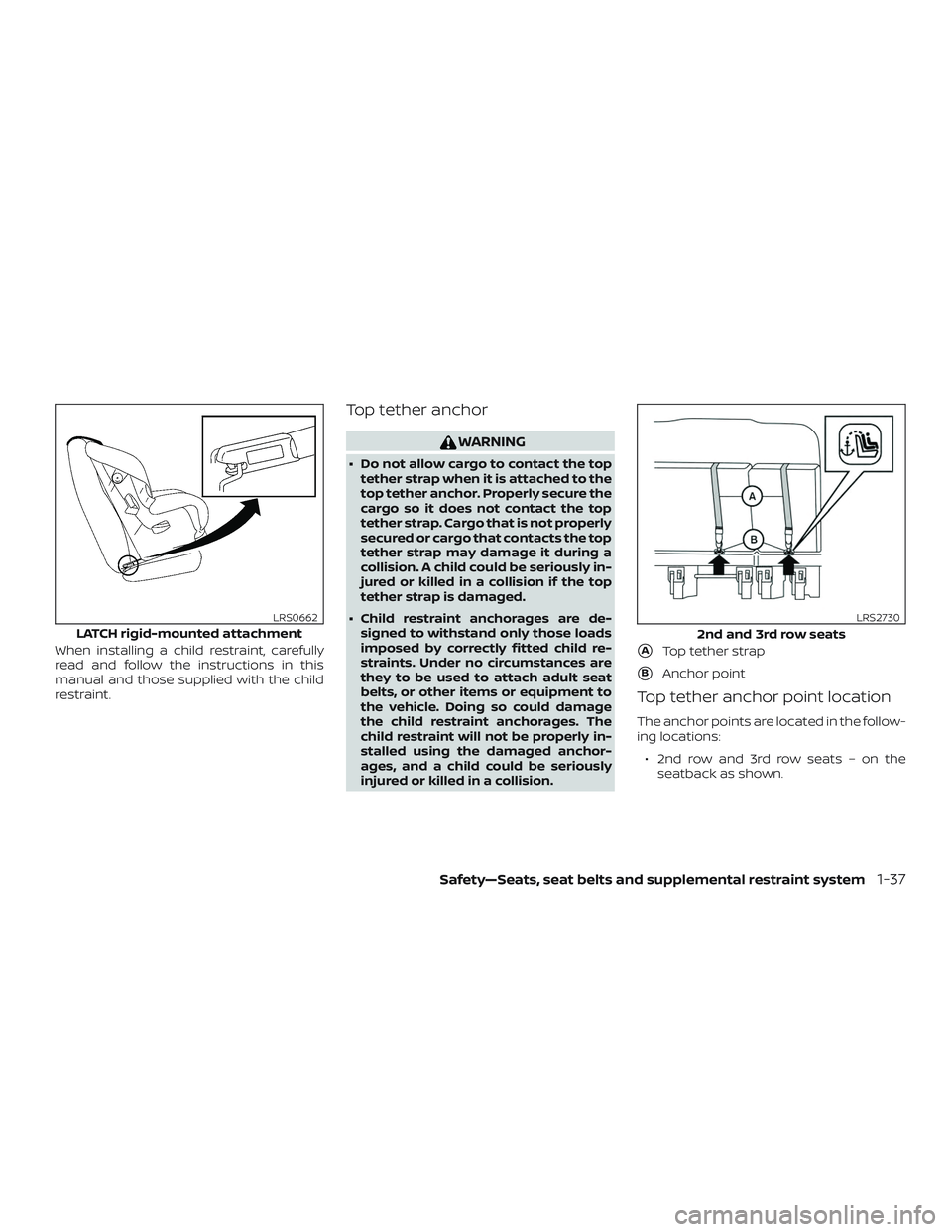
When installing a child restraint, carefully
read and follow the instructions in this
manual and those supplied with the child
restraint.
Top tether anchor
WARNING
∙ Do not allow cargo to contact the toptether strap when it is attached to the
top tether anchor. Properly secure the
cargo so it does not contact the top
tether strap. Cargo that is not properly
secured or cargo that contacts the top
tether strap may damage it during a
collision. A child could be seriously in-
jured or killed in a collision if the top
tether strap is damaged.
∙ Child restraint anchorages are de- signed to withstand only those loads
imposed by correctly fitted child re-
straints. Under no circumstances are
they to be used to attach adult seat
belts, or other items or equipment to
the vehicle. Doing so could damage
the child restraint anchorages. The
child restraint will not be properly in-
stalled using the damaged anchor-
ages, and a child could be seriously
injured or killed in a collision.
�ATop tether strap
�BAnchor point
Top tether anchor point location
The anchor points are located in the follow-
ing locations:
∙ 2nd row and 3rd row seats – on the seatback as shown.
LATCH rigid-mounted attachment
LRS0662
2nd and 3rd row seats
LRS2730
Safety—Seats, seat belts and supplemental restraint system1-37
Page 59 of 426
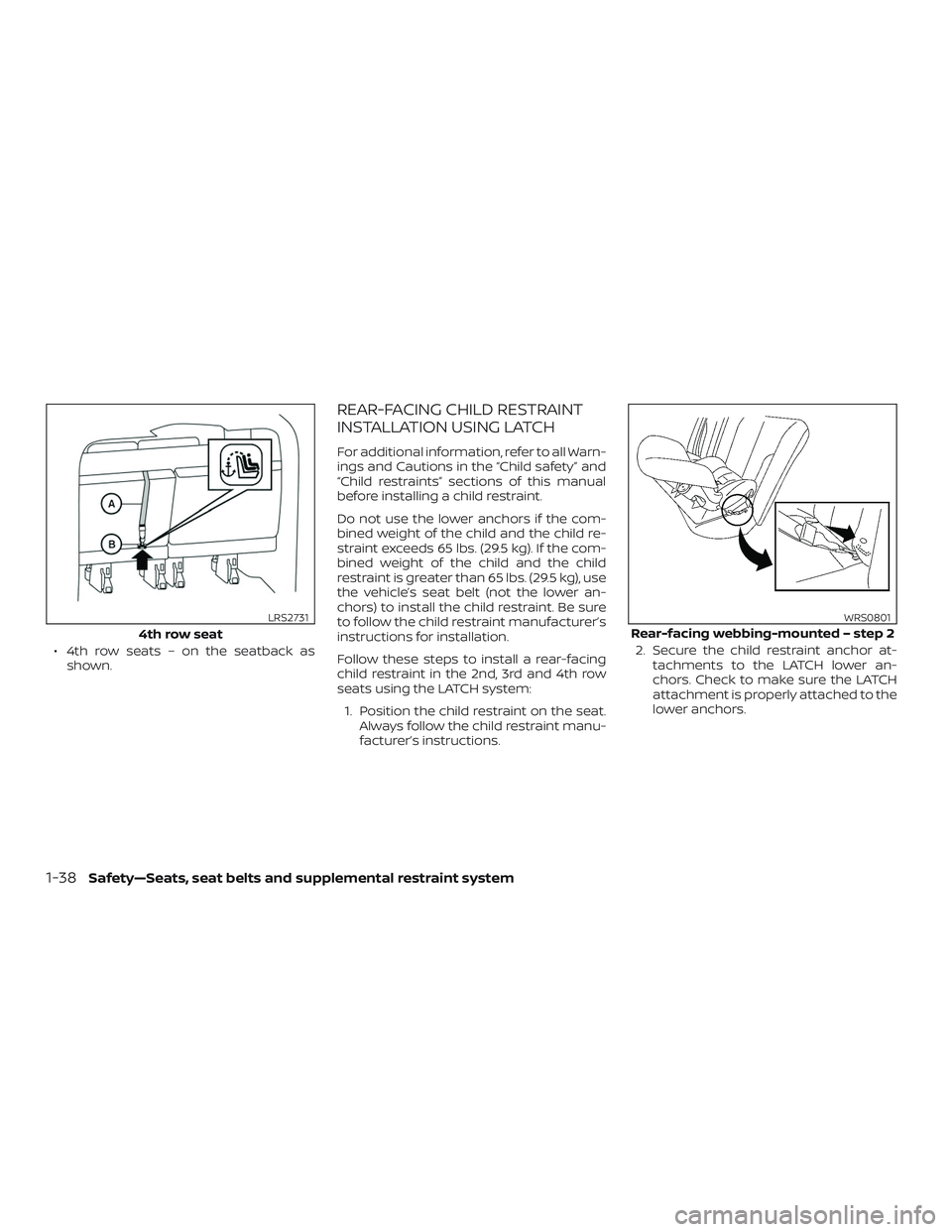
∙ 4th row seats – on the seatback asshown.
REAR-FACING CHILD RESTRAINT
INSTALLATION USING LATCH
For additional information, refer to all Warn-
ings and Cautions in the “Child safety” and
“Child restraints” sections of this manual
before installing a child restraint.
Do not use the lower anchors if the com-
bined weight of the child and the child re-
straint exceeds 65 lbs. (29.5 kg). If the com-
bined weight of the child and the child
restraint is greater than 65 lbs. (29.5 kg), use
the vehicle’s seat belt (not the lower an-
chors) to install the child restraint. Be sure
to follow the child restraint manufacturer’s
instructions for installation.
Follow these steps to install a rear-facing
child restraint in the 2nd, 3rd and 4th row
seats using the LATCH system:
1. Position the child restraint on the seat. Always follow the child restraint manu-
facturer’s instructions. 2. Secure the child restraint anchor at-
tachments to the LATCH lower an-
chors. Check to make sure the LATCH
attachment is properly attached to the
lower anchors.
4th row seat
LRS2731
Rear-facing webbing-mounted – step 2
WRS0801
1-38Safety—Seats, seat belts and supplemental restraint system
Page 60 of 426
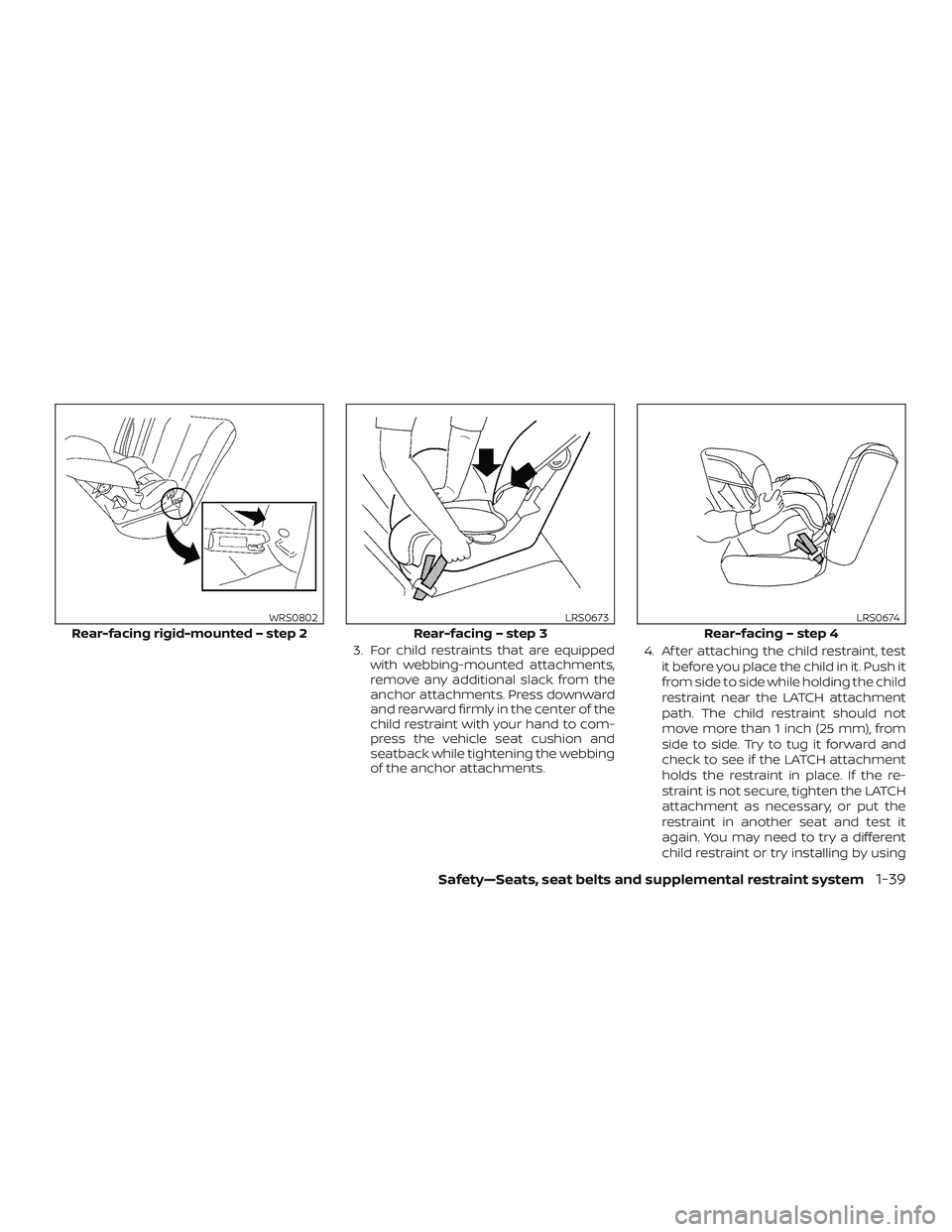
3. For child restraints that are equippedwith webbing-mounted attachments,
remove any additional slack from the
anchor attachments. Press downward
and rearward firmly in the center of the
child restraint with your hand to com-
press the vehicle seat cushion and
seatback while tightening the webbing
of the anchor attachments. 4. Af ter attaching the child restraint, test
it before you place the child in it. Push it
from side to side while holding the child
restraint near the LATCH attachment
path. The child restraint should not
move more than 1 inch (25 mm), from
side to side. Try to tug it forward and
check to see if the LATCH attachment
holds the restraint in place. If the re-
straint is not secure, tighten the LATCH
attachment as necessary, or put the
restraint in another seat and test it
again. You may need to try a different
child restraint or try installing by using
Rear-facing rigid-mounted – step 2
WRS0802
Rear-facing – step 3
LRS0673
Rear-facing – step 4
LRS0674
Safety—Seats, seat belts and supplemental restraint system1-39
Page 61 of 426
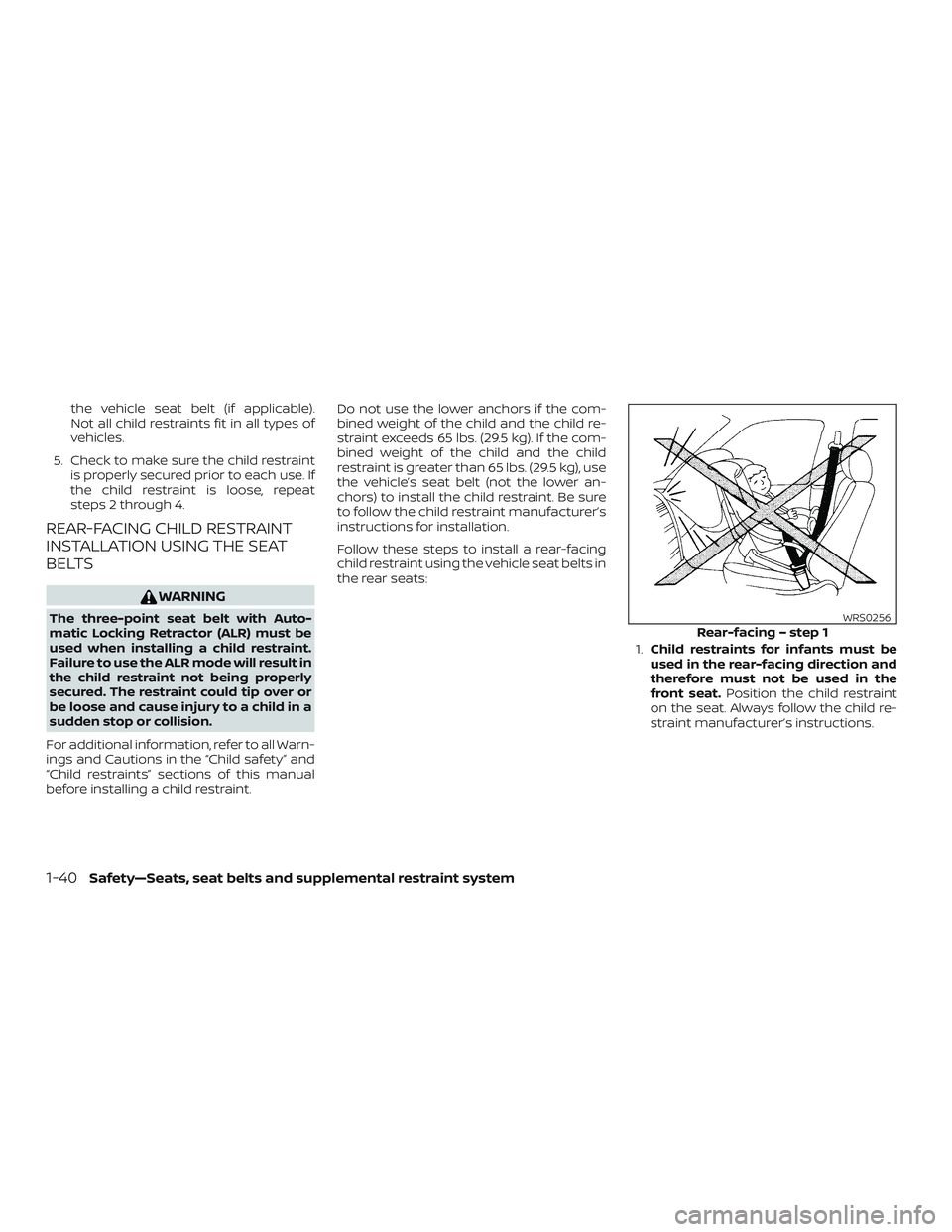
the vehicle seat belt (if applicable).
Not all child restraints fit in all types of
vehicles.
5. Check to make sure the child restraint is properly secured prior to each use. If
the child restraint is loose, repeat
steps 2 through 4.
REAR-FACING CHILD RESTRAINT
INSTALLATION USING THE SEAT
BELTS
WARNING
The three-point seat belt with Auto-
matic Locking Retractor (ALR) must be
used when installing a child restraint.
Failure to use the ALR mode will result in
the child restraint not being properly
secured. The restraint could tip over or
be loose and cause injury to a child in a
sudden stop or collision.
For additional information, refer to all Warn-
ings and Cautions in the “Child safety” and
“Child restraints” sections of this manual
before installing a child restraint. Do not use the lower anchors if the com-
bined weight of the child and the child re-
straint exceeds 65 lbs. (29.5 kg). If the com-
bined weight of the child and the child
restraint is greater than 65 lbs. (29.5 kg), use
the vehicle’s seat belt (not the lower an-
chors) to install the child restraint. Be sure
to follow the child restraint manufacturer’s
instructions for installation.
Follow these steps to install a rear-facing
child restraint using the vehicle seat belts in
the rear seats:
1.Child restraints for infants must be
used in the rear-facing direction and
therefore must not be used in the
front seat. Position the child restraint
on the seat. Always follow the child re-
straint manufacturer’s instructions.Rear-facing – step 1WRS0256
1-40Safety—Seats, seat belts and supplemental restraint system
Page 62 of 426
2. Route the seat belt tongue through thechild restraint and insert it into the
buckle until you hear and feel the latch
engage. Be sure to follow the child re-
straint manufacturer’s instructions for
belt routing. 3. Pull the shoulder belt until the belt is
fully extended. At this time, the seat belt
retractor is in the ALR mode (child re-
straint mode). It reverts to the ELR
mode when the seat belt is fully re-
tracted. 4. Allow the seat belt to retract. Pull up on
the shoulder belt to remove any slack
in the belt.
Rear-facing – step 2
WRS0761
Rear-facing – step 3
LRS0669
Rear-facing – step 4
LRS0670
Safety—Seats, seat belts and supplemental restraint system1-41